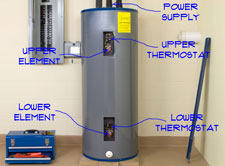This article covers the steps involved with installing hot water heater elements. At this point you should have determined that your elements are bad. If not, you need to see the article on 'Testing Electric Hot Water Heater Elements', for information on how to check them.
Not sure if the elements are your problem? See the article on 'Troubleshooting for Electric Water Heaters' or 'Gas Hot Water Heater Troubleshooting' to find a complete listing of water heater problems and the associated information that will provide solutions.
To install a hot water heating element you need to first, 'purchase the correct elements'. Second, you will have to 'shut down' and and 'drain your water heater'.
Once you have the correct parts and the water heater prepared, you will need to remove the old elements and install the new ones. This article covers the last two steps in this process.
Shutting Down the Water Heater
You can not work on the the heating elements until you have shut down the power to the water heater and drained the tank. The water inside your tank is hot and can scald or burn your skin. In addition, the electrical current that is used to heat the water can injure or even kill you.
Before you begin, review the article on 'Shutting Down and Electric Hot Water Tank'. This article gives you the step by step procedure that you need to follow.
Removing the Old Water Heater Elements
 Now you have to get to the elements. Remove the two covers on the side of the hot water tank. There may be some batt insulation covering the elements. Push it back out of the way. You should see the thermostat, reset button and elements.
Now you have to get to the elements. Remove the two covers on the side of the hot water tank. There may be some batt insulation covering the elements. Push it back out of the way. You should see the thermostat, reset button and elements.
The element should have two wires hooked to it. It should not matter which way they are hooked up, both of them are hot leads (120 volts each to give you 240 volts total). Double check the leads with the tester, remember, no power. Unhook the leads, tag them if you want to. Push the wire to the side. In fact put a couple of wire nuts on them while you are working on it.
Most hot water heater elements on newer models are a screw in type. You need a large socket wrench for this type. They sell a special wrench for $7 or $8 dollars. You may not have an 1 1/2" socket wrench. Does your neighbor have one? Use a socket wrench or buy to wrench. Don't try to get them out with channel locks. Breaking it will be a big problem.
The other type of element has a flange with four bolts on it. Again you will use a socket wrench to remove it. Not rocket science here, remove the bolts and presto, the element comes out.
With your elements out you are ready to do one of two things. Get new ones to replace them. The other would be to clean the scale off of the ones you have and re-install them. You can clean the scale off the elements with a wire brush in the sink. Be careful not to damage them. Remove the rust and build up off the heating surfaces. Let them dry before you install them.
Getting the old one out was most of the work. Now the easy part.
Installing New Water Heater Elements
Installing Screw Type Elements
This is the easiest element to install. The opening in the side of the tank is threaded to match the element. Your going to need the socket wrench that you used to remove the old element and some pipe dope.
Use some pipe dope on a threaded hot water heater element. Screw it in by hand at first, making sure not to cross thread it. Once you are sure that it is threading in correctly, you can use the 1 1/2" socket wrench to tighten it. Make sure the element is tight.
Installing Flanged Elements
A flanged water heating element is held in place with four bolts. These are usually found on older water heaters. Clean the area where the flange goes to get a good seal.
Insert the element into the hole and start the four bolts into the holes. Tighten them down evenly
Using a Flanged Adapter Kit
Did you get a kit for a flanged element? Follow the instructions that come with the kit. A flanged element will have a gasket on it that you need to get aligned properly. Clean the area around the opening first to make sure you get a good seal. Tighten up the bolts on the element with the socket wrenches.
Hook Up the wiring
After the elements are installed you can attach the wires. It does not matter which terminal each wire is attached, both of them are hot leads. You have two wires for each element. Make sure the terminals are tight.
Starting the Hot Water Heater Up
Do not turn the power back on until the water tank is filled with water. See the instructions in the article 'Turning On a Hot Water Heater' for the procedure that should be followed.
Turning on the power before the tank is filled can damage the heating elements. This would not be good news for a brand new set of heating elements.
Checking For Leaks
After the water has heated up, check the elements for leaks. Shut the power back off before you do this. If there are no leaks, you can replace the cover plates and turn the power back on.

